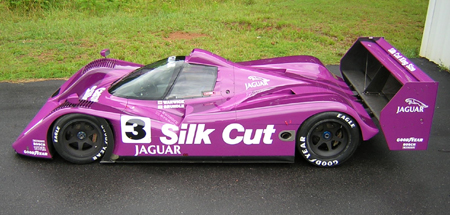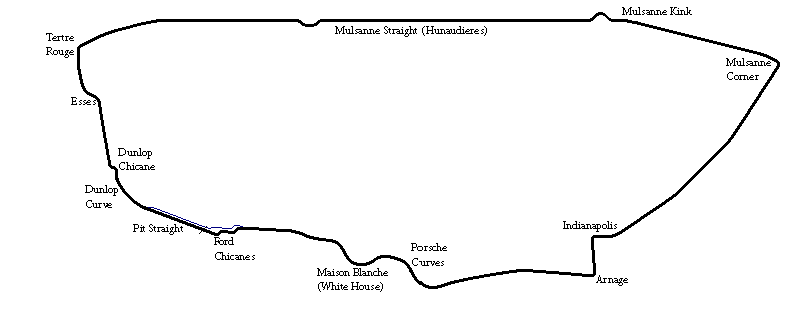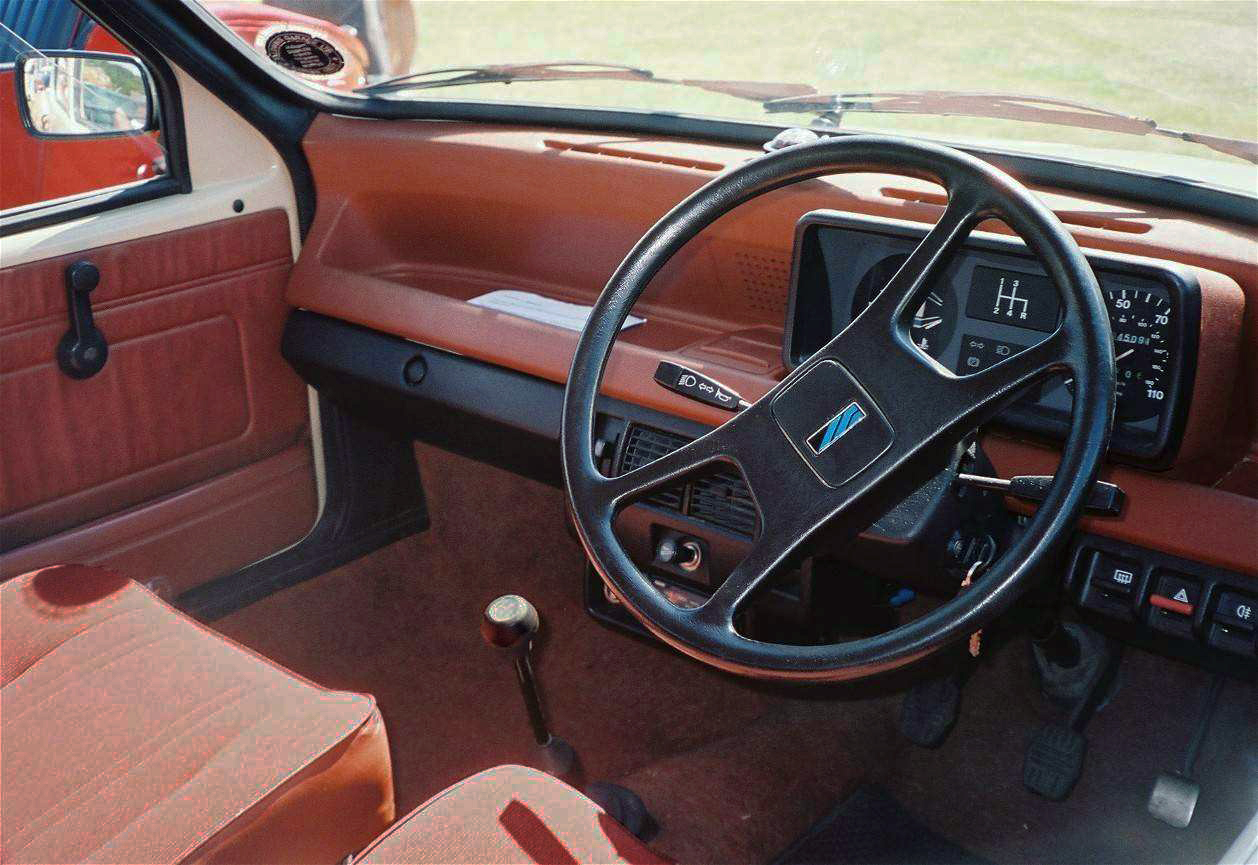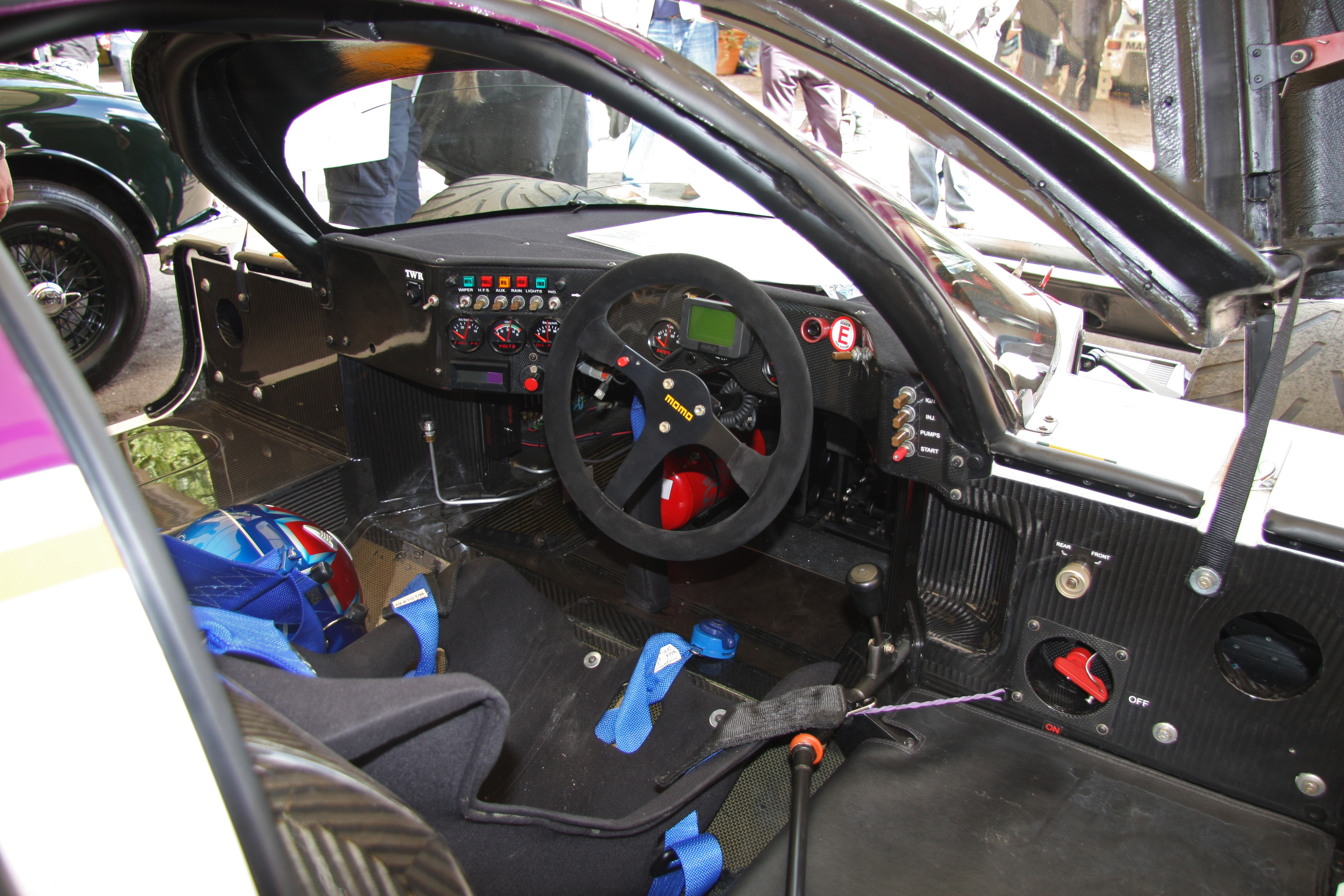|
Jaguar XJR-14
The Jaguar XJR-14 is a sports-prototype racing car introduced for the 1991 World Sportscar Championship season. It was designed by Ross Brawn and John Piper, and was built and run by Tom Walkinshaw Racing (TWR), on behalf of Jaguar Cars. Design The 1991 season marked the introduction of the FIA’s new, and controversial, 3.5 Litre Formula which replaced the highly successful Group C category that had been used in the World Sports Car Championship since 1982. However, due to a small number of entries in the new 3.5 litre formula heavily penalised Group C cars were allowed participate in the newly created C2 category for the 1991 season but Jaguar participated in the new formula. To comply with the new regulations Jaguar produced an all-new car, the XJR-14. It was designed by Ross Brawn and John Piper, and was built by Tom Walkinshaw Racing (TWR). In the past, TWR's Jaguars had been designed under the direction of Tony Southgate, while Brawn worked with a large design staff (12 ac ... [...More Info...] [...Related Items...] OR: [Wikipedia] [Google] [Baidu] |
Goodyear Tire And Rubber Company
The Goodyear Tire & Rubber Company is an American multinational tire manufacturing company founded in 1898 by Frank Seiberling and based in Akron, Ohio. Goodyear manufactures tires for automobiles, commercial trucks, light trucks, motorcycles, SUVs, race cars, airplanes, farm equipment and heavy earth-moving machinery. It also makes bicycle tires, having returned from a break in production between 1976 and 2015. As of 2017, Goodyear is one of the top five tire manufacturers along with Bridgestone (Japan), Michelin (France), Continental (Germany) and MRF (India). The company was named after American Charles Goodyear (1800–1860), inventor of vulcanized rubber. The first Goodyear tires became popular because they were easily detachable and required little maintenance. Though Goodyear had been manufacturing airships and balloons since the early 1900s, the first Goodyear advertising blimp flew in 1925. Today, it is one of the most recognizable advertising icons in America. The ... [...More Info...] [...Related Items...] OR: [Wikipedia] [Google] [Baidu] |
Jaguar XJR-12
The Jaguar XJR-12 is a sports-prototype race car built by the Jaguar Cars-backed Tom Walkinshaw Racing team for both Group C and IMSA Camel GTP. The XJR-12 is famous for winning the 1990 24 Hours of Le Mans race. Weighing 900 kg and powered by a 7.0 L 60 degree SOHC V12 developing 730 horsepower / 545 kW @ 7000 rpm, and 579 ft lbf / 785 N·m @ 5500 rpm, the XJR-12 could hit 368 km/h / 229 mph. During the 1990 24 Hours of Le Mans, the XJR-12 covered 4882.4 km at an average speed of 204.036 km/h / 126.782 mph with a maximum trap speed of 353 km/h / 219 mph. See also * Jaguar XJR sportscars The Jaguar XJR sportscars were a series of race cars used by Jaguar-backed teams in both the World Sportscar Championship (WSC) Group C and the IMSA Camel GTP series between 1984 and 1993. History Starting in 1983, the project was started by a ... References External links {{IMSA GTP Cars XJR-12 Group C cars IMSA GTP cars Re ... [...More Info...] [...Related Items...] OR: [Wikipedia] [Google] [Baidu] |
1991 24 Hours Of Le Mans
The 1991 24 Hours of Le Mans was the 59th Grand Prix of Endurance, and took place on 22 and 23 June 1991. It was also the fourth round of the 1991 FIA Sportscar World Championship season. Pre-race An entirely new complex along the front stretch was built, housing modern pit stalls, garages, and the new observation suites built above the garages. As for the race, the grid line-up was an unusual affair. 1991 was supposed to be the first year the World Sportscar Championship ran to the new '3.5L' rules, which meant a new breed of sports-prototypes. Although TWR-Jaguar, Mercedes-Benz and Peugeot all built cars to the new regulations for the 1991 championship series, the number of privateer teams was low and there was simply not enough of these new cars to fill the grid. The FIA allowed the first 10 spaces on the grid to be reserved for the fastest qualifying 3.5L cars from the World Sportscar Championship, while the rest of the field was made up of older formula Group C cars. In ... [...More Info...] [...Related Items...] OR: [Wikipedia] [Google] [Baidu] |
Mercedes-Benz C291
The Mercedes-Benz C291 was a sports-prototype racing car introduced for the 1991 World Sportscar Championship season. It was Mercedes-Benz’ final car in the Group C category. Introduction The 1991 season marked the introduction of the FIA’s new, and controversial, 3.5 litre formula which replaced the highly successful Group C category that had been used in the World Sportscar Championship since 1982, though due to a small number of entries for the 3.5 litre formula heavily penalised Group C cars (which were subject to weight penalties and started behind the new-style C1 entries on the grid) were allowed to participate in the season's C2 category. To meet the new regulations Mercedes-Benz came up with an all-new car; the C291 which was designed by its racing partner Sauber. One survived and is on display in the Carl Benz Museum in Ladenburg, Germany. Another one is located in the Michael Schumacher Collection in Cologne, and this is the Autopolis-winning chassis. Engine The pr ... [...More Info...] [...Related Items...] OR: [Wikipedia] [Google] [Baidu] |
Peugeot 905
The Peugeot 905 is a sports-prototype racing car built by Peugeot's racing department, Peugeot Talbot Sport. The car was initially unveiled in February 1990 and was developed throughout 1990 before making its race debut in the final two races of the 1990 World Sportscar Championship season (Montréal and Mexico). The car won the 24 Hours of Le Mans endurance race in 1992 with the team of Derek Warwick, Yannick Dalmas, and Mark Blundell. This win was followed in 1993 by the team of Geoff Brabham, Christophe Bouchut, and Éric Hélary, in the 905B. In addition to that, the car won both the driver’s and the team’s title at the World Sportscar Championship in 1992. The Peugeot 905 participated in 17 races in its career, winning 9 of them. History Inception In November 1988 Peugeot Talbot Sport, established under the control of Jean Todt at Vélizy-Villacoublay, in the suburbs of Paris, announced the launch of the 905 project to compete in the 1991 World Sportscar Cham ... [...More Info...] [...Related Items...] OR: [Wikipedia] [Google] [Baidu] |
Metro 6R4
The Metro is a supermini car, later a city car that was produced by British Leyland (BL) and, later, the Rover Group from 1980 to 1998. It was launched in 1980 as the Austin mini Metro. It was intended to complement and eventually replace the Mini, and was developed under the codename LC8. The Metro was named by ''What Car?'' magazine as 'Car of The Year' in 1983 as an MG Cars, MG, and again as the Rover (marque), Rover Metro in 1991. During its 18-year lifespan, the Metro wore many names: Austin Metro, MG Metro and Rover Metro. It was rebadged as the Rover 100 series in December 1994. There were also van versions known as the Morris Metro and later, Metrovan. At the time of its launch, the Metro was sold under the Austin Motor Company, Austin brand. From 1982, MG (car), MG versions became available. During 1987, the car lost the Austin name, and was sold simply as the Metro. From 1990 until its withdrawal in 1998, the Metro was sold only as a Rover (car), Rover. Although the ... [...More Info...] [...Related Items...] OR: [Wikipedia] [Google] [Baidu] |
Jaguar XJR-11
The Jaguar XJR-11 was a sports-prototype racing car introduced for the 1989 World Sports Prototype Championship, while its sister car the XJR-10 was introduced to compete in IMSA series races. Development For the 1989 season, Tom Walkinshaw realised that the TWR produced V12 Jaguar sports prototypes were lacking competitiveness, especially in short sprint events. The small, light weight forced induction engines used by competitors such as Mercedes-Benz outperformed the big, naturally aspirated engines that Jaguar Sport had been using since the start of the programme. Jaguar started development of a new engine in order to stay competitive. The Rover V64V 3.5 L V6 engine originally designed for the MG Metro 6R4 rally car proved to be an ideal engine for the new car, with its weight of just and consistent performance. Jaguar developed two variants of the engine: the 3.0 L variant was intended for competition in the IMSA series and the 3.5 L variant was intended for competition i ... [...More Info...] [...Related Items...] OR: [Wikipedia] [Google] [Baidu] |
Naturally Aspirated Engine
Naturally may refer to: ;Albums * ''Naturally!'', an album by Nat Adderley * ''Naturally'' (Houston Person album) * ''Naturally'' (J. J. Cale album) * ''Naturally'' (John Pizzarelli album) * ''Naturally'' (Sharon Jones album) * ''Naturally'' (Three Dog Night album) ;Songs * "Naturally" (Deborah Gibson song) * "Naturally" (Kalapana song) * "Naturally" (Selena Gomez & the Scene song) * "Naturally", a song by Ayumi Hamasaki from '' I Am...'' * "Naturally", a song by Heatwave from ''Current'' * "Naturally", a song by Huey Lewis and the News from ''Fore!'' * "Naturally", a song by Raffi from ''Bananaphone'' * "Naturally", a song by Fat Mattress from ''Fat Mattress II'' * "Naturally", a song by Katy Hudson (better known by her current stage name Katy Perry Katheryn Elizabeth Hudson (born October 25, 1984), known professionally as Katy Perry, is an American singer, songwriter, and television personality. Known for her influence on modern pop music and her Camp (style), cam ... [...More Info...] [...Related Items...] OR: [Wikipedia] [Google] [Baidu] |
Tony Southgate
Tony Southgate (born 25 May 1940, Coventry, England) is a British engineer and former racing car designer. He designed many successful cars, including Jaguar's Le Mans-winning XJR-9, and cars for almost every type of circuit racing. He was responsible for the chassis design of Ford's RS200 Group B rally car. Southgate was employed as chief designer or technical director for many Formula One teams for over twenty years. These teams included BRM, Shadow and Arrows. Southgate retired after producing the Audi R8C, which was a major influence in the Bentley Speed 8, which won Le Mans in 2003. He continues to be a regular visitor to current and historic race meetings. Southgate is the only chief engineer to have won the Triple Crown of Motorsport with his cars: Indianapolis 500 with Eagle TG2 in 1968, the Monaco Grand Prix with the BRM P160B and the 24 Hours of Le Mans in 1988 and 1990 with Jaguar XJR-9 and Jaguar XJR-12. Early career at Lola and Eagle Tony Southgate became interes ... [...More Info...] [...Related Items...] OR: [Wikipedia] [Google] [Baidu] |
The Daily Telegraph
''The Daily Telegraph'', known online and elsewhere as ''The Telegraph'', is a national British daily broadsheet newspaper published in London by Telegraph Media Group and distributed across the United Kingdom and internationally. It was founded by Arthur B. Sleigh in 1855 as ''The Daily Telegraph & Courier''. Considered a newspaper of record over ''The Times'' in the UK in the years up to 1997, ''The Telegraph'' generally has a reputation for high-quality journalism, and has been described as being "one of the world's great titles". The paper's motto, "Was, is, and will be", appears in the editorial pages and has featured in every edition of the newspaper since 19 April 1858. The paper had a circulation of 363,183 in December 2018, descending further until it withdrew from newspaper circulation audits in 2019, having declined almost 80%, from 1.4 million in 1980.United Newspapers PLC and Fleet Holdings PLC', Monopolies and Mergers Commission (1985), pp. 5–16. Its si ... [...More Info...] [...Related Items...] OR: [Wikipedia] [Google] [Baidu] |
World Sportscar Championship
The World Sportscar Championship was the world series run for sports car racing by the FIA from 1953 to 1992. The championship evolved from a small collection of the most important sportscar, endurance, and road racing events in Europe and North America with dozens of gentleman drivers at the grid, to a professional racing series where the world's largest automakers spent millions of dollars per year. The official name of the series changed throughout the years, however it has generally been known as the World Sportscar Championship from its inception in 1953. The World Sportscar Championship was, with the Formula One World Championship, one of the two major world championships in circuit motor racing. In 2012 the World Sportscar Championship was revived and renamed as the World Endurance Championship. Races The most famous event was the 24 Hours of Le Mans which was the part of the championship in every season except of the 1956, 1975– 79 and 1989– 90 seasons. Th ... [...More Info...] [...Related Items...] OR: [Wikipedia] [Google] [Baidu] |






